
Material Properties
Your masterclass in product design and development
Protolabs’ Insight video series
Our Insight video series will help you master digital manufacturing.
Every Friday we’ll post a new video – each one giving you a deeper Insight into how to design better parts. We’ll cover specific topics such as choosing the right 3D printing material, optimising your design for CNC machining, surface finishes for moulded parts, and much more besides.
So join us and don’t miss out.
Insight: Material Properties
Transcript
Hi, it’s Friday which means it’s time for another Insight video from me.
Each week we take a look at a different aspect of additive manufacturing. In this week's video we look at material properties and what you need to have in mind when considering the role your part has to play.
We talk a lot about part design in these videos, and when we do so most of our thought is going to go on the fairly obvious factors - shape, size, wall thicknesses and so on. However, less obvious but equally important can be the characteristics of the material you make it from.
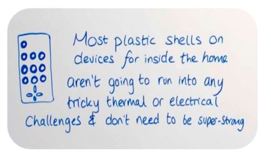
Now, sometimes the choice of material can be pretty incidental to its performance. For example, most plastic shells on devices for inside the home aren’t going to be running into any tricky thermal or electrical challenges and don’t need to be super-strong, so you don’t need to be too picky about what you make them from.

On the other hand, think about a housing for a motorbike’s air cleaner. On a base level its purpose is pretty much the same as that plastic shell, but this time it needs to handle flying debris, heat from the engine and UV radiation from being out in the sun. It’ll get wet, it’ll get fuel and cleaning chemicals on it… This time the choice of material really does matter.

The earlier in the design process you start thinking about what materials you want to use and their properties, the more effective and economical your finished design will be. And I know that sounds a little obvious when I say it like that, but it’s easy to only start thinking about materials when you’re getting ready to produce your prototypes, and if you suddenly find that the plastic or metal you want doesn’t quite fit in with the plans… You see the problem.
Anyway, this video is all about helping you with that early evaluation.

The first step in this is making sure you have a clear understanding of what the complete device or assembly has to do, and what role this particular part has in in that overall operation. Where there are multiple considerations that bump into each other you’ll have to prioritise, separating the ‘must haves’ from the ‘nice-to-haves’.
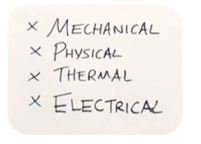
The list of possible properties you have to weigh in the balance is pretty long, but the important parts will typically fall into four categories: mechanical, physical, thermal, and electrical. There’s a lot of detail to consider here, but for now let’s have a quick run through of the important bits.
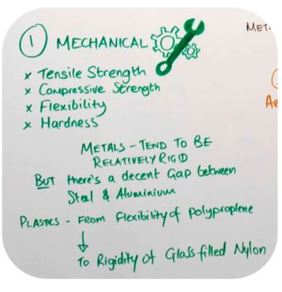
First up, mechanical.
Simply put, mechanical properties are those that a material exhibits when it has a force applied to it. These include its tensile and compressive strength, its flexibility and its hardness.
Metals tend to be relatively rigid, though there’s still a pretty decent gap between the stiffness of steel and aluminium. Plastics are much more varied and can run from the flexibility of polypropylene all the way to the rigidity of glass-filled nylon.
It can be easy to mix these mechanical properties up with physical properties – I mean, aren’t all the properties physical? That’s possibly a question for another video; for the purposes of this one, when we talk about physical properties, we mean a material’s cosmetic characteristics and its response to chemicals or radiation. These include density and resistance to chemical corrosion and UV breakdown, as well as more cosmetic issues like colour and surface texture.

Again, the physical properties of plastics will vary widely. Urethanes, for example, are a poor choice for moist environments, while 3D-printed plastics produced by stereolithography will become brittle if exposed to UV light.
Metals are a little less widespread, but they also vary in their tolerance to chemical exposure. Stainless steel is an obvious choice for many potentially corrosive environments but will come up short in other areas such as heat transfer.
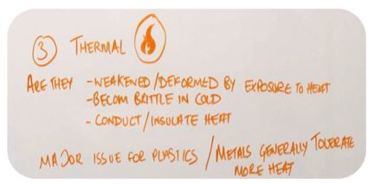
That moves us along to thermal properties. If it wasn’t obvious, these are the properties that govern a material’s response to temperature. Are they weakened or deformed by exposure to heat or do they become brittle in response to cold? Does the material conduct heat or insulate?
This can be a major issue when it comes to choosing plastics. Even if you don’t plan on sticking your part in an oven, there are plenty of parts you want to be able to survive a summer’s day in the car, for example.
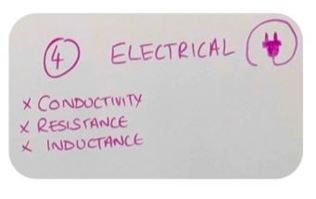
Fortunately, metals can generally tolerate higher heat than many plastics, though you need to start getting a little pickier when you start stretching into the hundreds of degrees.
Finally, we have electrical properties. These are all about characteristics such as conductivity, resistance, and inductance – all that stuff you had to learn about in physics classes.
Sometimes you aren’t going to worry too much about these properties, sometimes they’re going to be incredibly important. Think about medical devices, for example, in which strong currents or magnetic fields are used for diagnostics or treatment.
When it comes to actually choosing a material, you need to weigh up all of these different properties. While a lot of designers have a few “go-to” materials they use, in some cases you might be giving up benefits that you could discover with a bit of research.
So, think carefully about your choice of material and as always talk to your supplier they may have some suggestions.
Right that’s it from me this week. Have a great weekend and I’ll see you next week.
With special thanks to Natalie Constable.










